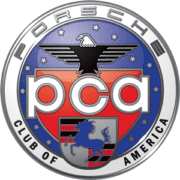Trying Times
Driver’s Log
By Tom Swift
Trying Times
It is late February, and we have under our belt our two annual driver seminars: In January for those who have never been to a DE or an autocross and in February for our instructors and our advanced drivers. Both events were well attended and we had an eager group of about 35 novices, most of whom seem ready to start their engines.
Upcoming Events
In May we will be at Mid Ohio again this year in partnership with our friends from Potomac Region. This proved to be a wonderful partnership last year, as both regions think very similarly about how to organize and run a DE, and the Potomac people I met were delightful. The Mid Ohio track is very different from, say, Watkins Glen. At the Glen virtually all turns are connected to straights (the esses and the inner loop being the exceptions). At Mid Ohio a large portion of the track consists almost entirely of connected turns. This makes it more of a challenge to develop a rhythm, but in my view also much more satisfying when you get in a good lap. It is also a track that rewards handling and talent more than horsepower, so a well driven Cayman can do very well up against a GT3. If you like a winding road, this track is for you. And feel free to ask me about the terrific rib joint not far from the track.
In early June we are going back to NJMP, this time for two days on Thunderbolt. At first I must admit that I did not immediately love this track, especially the set of turns known as the Octopus. However, after running it now a bunch of times, I have come to appreciate it more. It has some nice mid to high speed sweepers and it is hard to argue with the 100 mile distance from home, plus some quite good restaurants that are now to be found in the area.
Otherwise, the news is currently dominated by the impending presidential election. Everyone seems appalled in some way – either at the state of the country or at the state of the candidates, or both. Indeed, these are trying times. Rather than rant about the state of politics, or the sorry state of driving in NJ, or the fact that all incoming 991 GT3RSs are now either spoken for or priced in the stratosphere, I would like to separate the “trying” from the “times” and focus on the “trying.”
Trying: Driver education for the first time
For many years I could not bear the thought of putting my beloved sports cars into harms way on the track. No, not the 240Z, not the 924 turbo, not the 930. It took a mishap on the Garden State Parkway to convince me that perhaps my fears were misplaced. I was in very heavy, fast moving traffic with little distance between cars. All of a sudden there was a large hunk of metal dead center in my lane, which the car in front had apparently straddled with no ill effect. I had cars on both sides, so I had to stay in my lane and was forced to straddle it. Alas, it was 1 inch higher than the floor pan of my 930 – and that did substantial and expensive damage. If I could do that kind of damage on the GSP, why was I so worried about the track?
Shortly thereafter I found myself in a state that I had never been to, West Virginia, staying in a run down motel, nervously eating a junk food breakfast in anticipation of doing violence to my car. But after the first few laps around Summit Point, I realized that whatever risk I was running with the car was inconsequential compared to the sheer exhilaration and joy of moving swiftly through those curves on the “talent” portion of Summit Point.
Moral: Neither you nor your car are going to live forever. Nobody says on their deathbed: “Gee, I really regret that stone chip I picked up at Lightning.” Get thee to a track!
Trying: A new track
The second track I drove was Lime Rock. This was via the Skip Barber racing school. Our introduction to the track was novel: pile a dozen of us into a full size minivan and have a pro race driver take us around the track at a substantial clip. G-force induced pandemonium. I guess the strategy was to show us the track while creating such an absurd situation that we all relaxed a bit. Nevertheless it is hard to learn a track when most of your effort is dedicated to not falling over onto a stranger. However, after three days I knew the track, and as a bonus, I could also do heal and toe double clutch downshifts without having to think. Ah, the glory!
After many years of track driving, much of that “first time” thrill is gone. However, part of that excitement comes back when driving a track for the first time. Even with a lot of driving experience, there is still that wonderful combination of nervousness and excitement. How fast can I learn this? Where are the spots most likely to “get me?” Surely that cannot be Ramesh taking turn 4 faster than me?
Learning a new track today is easier than in the past. The easy availability of in-car videos, not to mention track simulators like iRacing, make it possible to get a good idea of a track well before that first lap.
Moral: Sign up for an event at a track you have not been to. Enjoy the thrill.
Trying: New equipment
No question that part of the attraction for many track drivers is the opportunity to acquire and try out new stuff. However, this is the part of our hobby that calls to mind the notion that “from the sublime to the ridiculous is but a step.” Let me illustrate that point with some personal experience. After a few events, I noticed that my right leg was really sore by the end of a day on the track. It was trying to keep me from sliding around the cockpit in my comfy but slippery leather seats. That first event with race seats and 5 point harnesses was truly sublime! Better control, better feel for what the car is doing, less fatigue and no paralysis of the left leg. On the other hand, I have seen a race trailer equipped with a built-in wine cooler where a tool box would normally have gone.
So goes the usual progression: racing brake pads => racing seats and harnesses and harness bar => brake cooling mods => in-car video => R compound tires => suspension mods => aero mods => engine mods => adding lightness => data acquisition. Whoops, forgot the open trailer and the tow vehicle. You get hooked on this stuff.
The ultimate in new equipment is the new vehicle. That progression has fewer steps for most of us, although I do know of a few whom I might characterize as automotive Casanovas. And today, with street cars that are as capable as full race cars of only ten years ago, you are not “forced” at some point into something that is very hot, very loud, very hard to get in and out of, requires race fuel and must be set up and serviced by rocket scientists. The full race car may no longer be at the end of the logical evolution of DE equipment.
Of course, if this were about logic, one would always ask the following question. Am I now driving my car at its limits on every inch of every track I go to? If yes, then clearly an upgrade is indicated. If not, then I do not need a new {insert expensive part, service or new car altogether}. There again, if this were about logic and cost effectiveness, we would all be driving Priuses and playing bridge.
But wait, isn’t this a thinking man and woman’s sport? Apparently, a lot of selective thinking is occurring.
Moral: Never, never, ever calculate the cost of this hobby. It will not change your behavior; it will not save you money. It will merely make you feel bad.
Trying: To make yourself a better driver
When I bought my cup car, I decided that aside from a cool suit system, a second seat and a data acquisition system, I would not attempt to “improve” the car. No upgrade to 3.8 liters, no fiddling with suspension bits or aero kit. The car was – and remains – swell above my ability to fully exploit. The best way to get number 539 to go faster is to improve the driver (OK, short of simply replacing the driver).
When you cut to the essence, the core of the NNJR DE program is to enable drivers to experience the exhilaration of driving their car on a race track – safely and quickly. Face it, any licensed driver can drive a track, flooring it on the straights and plodding around the turns, but it takes dedication and much practice to go through the curves with speed and grace, within the limits of the car and the driver. This is the educational essence of DE. We learn from instructors, classroom sessions, our peers and books (see https://nnjr-pca.com/wp-content/uploads/2016/02/NNJR-DE-Book-Suggestions-Jan-2016.pdf).
Technology has changed the way race drivers are coached and this technology is “trickling down” into DE. Many, if not most, drivers now have video cameras in cars. Some are running simple cell-phone based data acquisition systems. Some use more elaborate data systems. Some cars are now including rudimentary built-in data systems. At our instructor and advanced driver seminars this year, we focused on the use of video and data as tools to help improve driving and teaching, and more information is forthcoming on these topics. My conclusion is that video is less useful than most people imagine and data is much more useful. Video is great for sharing the experience and can be very useful in the unfortunate event of an incident. But the real power is in the data. By examining even the most basic data – position, distance and speed – one can yield very useful insights into driving technique. For example, the slope of the speed curve tells a great deal about whether a driver is coasting into the braking zone, how rapidly brake pressure is applied and the smoothness with which brake pressure is released. There is much to be gained by using these tools and I am resolved to personally do more to understand and use my data.
Moral: A dollar spent improving the driver is better spent that a dollar improving the car


